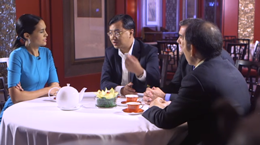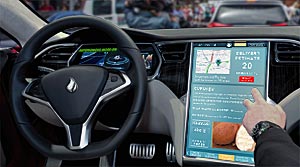Seeds of Disruption
How technology is remaking the future of food
Forecast Perspective: Convenience | Rethinking Shopping
Just-in-time delivery transforms consumer understandings of convenience

Over the next decade, the convergence of two forces will reshape consumers’ expectations about convenient food. First, as food shopping shifts from an activity performed in a restaurant or supermarket to something consumers engage in while driving, sitting at home, or waiting for the train, distinctions between fresh and fast food will blur. Second, automated systems for delivery will turn packaged foods into automated purchases. As these forces converge, they will transform any moment into an opportunity to shop and make obsolete many of the reasons to go shopping in a brick-and-mortar store.
Jump to:
Eating in this Future
Global Signals
Insights
Artifact from the Future
Download
EATING IN THIS FUTURE In the United States, Europe, and parts of Asia, new expectations around convenience emerge in urban areas where technology companies—including established players such as Amazon as well as emerging businesses such as TaskRabbit—offer same-day food delivery at lower and lower cost. Over time, these services become increasingly efficient and available outside a handful of dense cities.While these services initially take longer and cost more than going to a supermarket, they help urban consumers dramatically reduce time spent traveling to shop. These services first gain popularity as a time-saving strategy, appealing to those without cars and also to young parents.Consumers begin by using these shopping services to automate purchases of staple packaged foods such as cereal, snacks, and coffee. As comfort with these automated systems increases, consumers expand orders to meat and produce.Augmented-reality tools such as Google Glass enable traditional retailers as well as food manufacturers to provide consumers with the experience of a store, with features like easy to browse shelves, without the need for a physical store.Automated shopping features are subsequently built into cars and adopted by restaurants and cafes so that consumers can place fast food and coffee orders while in transit and pick up their orders in drive-through lines.Rail commuters are able to browse recipes while on the train and have all of the ingredients delivered and ready to prepare when they get home. Others set up food shopping to be automatic, akin to setting up electronic bill payment.As traditional paths to purchase are transformed over time, some food retailers refocus their efforts on providing services and experiences—such as cooking classes, food demonstrations, and nutrition advice. Many supermarkets close or shift toward providing delivery services. GLOBAL SIGNALS China Shopping Through Augmented-Reality Showrooms
 Yihaodian has been grabbing headlines worldwide for innovative augmented-reality showrooms and growing rapidly since its 2007 launch. What started as an online supermarket offering mostly fast-moving consumer products, now sells a much wider set of products through a wide variety of mobile and augmented-reality services. Recently, Yihaodian announced plans to develop 1,000 virtual supermarkets in vacant lots—using the viewfinder of a smart phone to enable shoppers to simulate the experience of a supermarket while making their way around the city.
Yihaodian has been grabbing headlines worldwide for innovative augmented-reality showrooms and growing rapidly since its 2007 launch. What started as an online supermarket offering mostly fast-moving consumer products, now sells a much wider set of products through a wide variety of mobile and augmented-reality services. Recently, Yihaodian announced plans to develop 1,000 virtual supermarkets in vacant lots—using the viewfinder of a smart phone to enable shoppers to simulate the experience of a supermarket while making their way around the city.
Source: Gang, Y. Co-founder: How China’s Yihaodian sees e-commerce. September 18, 2013.
Australia Coordinating Grocery Delivery to Commute Locations
 Marketed under the name “Click, Fly and Collect,” Woolworths groceries has launched a service to allow airplane passengers to pick up their groceries at the Melbourne Airport before heading home. Recognizing that more than 80,000 passengers travel through the airport on a daily basis, Woolworths hopes the service will appeal to passengers on the basis of time savings and convenience. It signals a broader shift—one where instead of heading to the supermarket, groceries meet shoppers at convenient, centralized locations.
Marketed under the name “Click, Fly and Collect,” Woolworths groceries has launched a service to allow airplane passengers to pick up their groceries at the Melbourne Airport before heading home. Recognizing that more than 80,000 passengers travel through the airport on a daily basis, Woolworths hopes the service will appeal to passengers on the basis of time savings and convenience. It signals a broader shift—one where instead of heading to the supermarket, groceries meet shoppers at convenient, centralized locations.
Source: Click&Collect by Woolworths
Brazil Creating Gourmet Convenience Foods
 Because of the pervasive fear of crime in major Brazilian cities, high-end delivery and convenience foods have become increasingly popular in recent years. These delivery services are being augmented by new lines of high-end, convenience food offered at stores including Amüse in Sao Paulo. Opened in December 2012, Amüse purveys a wide variety of gourmet vacuum-packed, canned and bottled foods, all produced without preservatives. The store bills its boutique ready-made food as a boon to those who want to prepare a special meal for friends—or simply to eat well—without having to leave home to shop for fresh ingredients.
Because of the pervasive fear of crime in major Brazilian cities, high-end delivery and convenience foods have become increasingly popular in recent years. These delivery services are being augmented by new lines of high-end, convenience food offered at stores including Amüse in Sao Paulo. Opened in December 2012, Amüse purveys a wide variety of gourmet vacuum-packed, canned and bottled foods, all produced without preservatives. The store bills its boutique ready-made food as a boon to those who want to prepare a special meal for friends—or simply to eat well—without having to leave home to shop for fresh ingredients.
Source: Amüse Food Store
INSIGHTS New expectations around convenience transform when and where people shop
As the physical store—both as a place for individuals to go and as a centralized distribution point—becomes less and less important to food shopping, the time, location, and other patterns that have shaped paths-to-purchase will be remade. These forces will simultaneously reduce the need to visit stores for staple purchases and create new kinds of just-in-time and impulse purchases.
Convenience becomes a baseline expectation
Over the course of the decade, designing convenience will move from being an advantage—as it is today—to becoming a necessary strategy for remaining competitive. Just as most people expect to be able to order just about any product seamlessly through a website today, they will soon expect the same convenience for ordering through phones, cars and other pieces of technology—it will become the standard.
Desires shift toward novel experiences
Stores such as Amüse in Brazil signal the need to think of convenience not as an end in itself, but as one of several values embedded in food products. This could be reflected in the development of luxury convenience foods, or in defining new experiential components to retail stores that bring novelty to shopping, but consumers will look for foods and offerings that take the hassle out of shopping while enhancing the experience of shopping and eating.
ARTIFACT FROM THE FUTURE Autonomous Vehicle Shopping Systems
What: You’ve been in stop-and-go traffic for almost an hour now. You normally use this time in the passenger seat of your self-driving car to finish up work emails, but all those are tended to, so you decide do some grocery shopping and surprise your kids with their favorite Amazonian fruits tonight. Your daughter loves cupuaçu, and you’re excited by the new “delay delivery” feature, which analyzes current traffic and makes sure that your purchase is routed to arrive home at the same time you do, so you can be the one to hand it to her directly.
So What: In a decade, new technologies of coordination will make it possible to order almost anything from anywhere and have it arrive at a designated place and time. New platforms and smart logistics systems are poised to disrupt the largely untapped market for fresh food delivery. As the cold chain expands in places such as Brazil or China, rapidly urbanizing areas might leapfrog the less efficient supermarket model in favor of streamlined food delivery systems.
Download: CONVENIENCE Forecast Perspective (PDF)Artifact from the Future - Autonomous Vehicle Shopping Systems (JPG) Explore the other Forecast Perspectives online: OVERVIEW | Remaking Food ExperiencesSATISFACTION | Personalized CravingsSUSTAINABILITY | Sourcing MindfulnessFRESHNESS | Quantifying Peak Flavors
